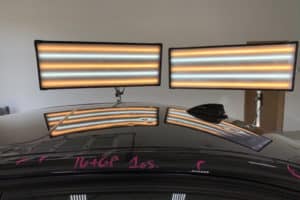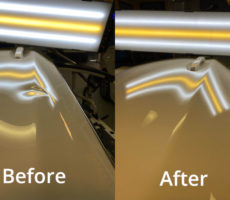The rule of the road means driving on one side of the road, and for most of us, it’s on the right side (RHT, or right-hand traffic). But what if you need to switch to the other side? Is it hard to adapt?
The first 10-15 minutes of driving on the other side will be hard, but your brain will quickly adjust. The usage of signals and parking may be a bit more difficult, but you’ll adapt to this in just a few days if you avoid big city driving and try to stay focused.
In general, switching to another side is not as daunting as you might think. People have been doing it for decades, and they do it every day. All it takes is a bit of practice.
The trick is to avoid big cities, try to stay on wide roads, and do some extra practice when parking and doing roundabouts. These are the most common problems, and if you pay attention to these you’ll be natural in no time.
How Hard Is It to Drive on the Opposite Side of the Road?

If you’re making a switch to the other side or thinking of doing it, you should know that it’s not especially hard to do it. The first 10-15 minutes will be hard, but eventually, you’ll get used to driving on the opposite side.
The biggest difficulty is these first few minutes where your brain needs to adjust to the opposites, but after that, it’s much easier. It takes a few days to become comfortable though, and the more your drive the easier it gets.
Pro tip: Invest in a good quality dash cam; it’s an invaluable tool for reviewing your driving habits, especially if you’re learning to drive on a different side of the road.
Some things remain difficult for a longer time such as parking or learning how to use signals. It’s normal to get confused with these, as the wheel is on the opposite side. You might mistake using turn signal instead of the windshield wipers. Takes time to get used to it, but general driving is fairly easy to learn if you just keep your focus on the road.
Oh, and don’t be surprised if you try to switch gears but hit the door instead. Quite common in the first few days.
Here’s a cool video of driving on the left in practice with some tips:
Is It Easier to Drive on the Left or Right?
Whichever’s the one you’re used to driving on, that’s the easier one. Truth is that neither side is easier or harder, it all depends on what you’re used to. You can even learn to drive effectively on both sides, with no difference in difficulty.
For some people though, a certain side may be preferable due to being strongly left or right-handed, or having some impairment. Other than that, they’re both of the same difficulty.
Is Left Hand Drive Safer?
Considering how there are more right-handed people in the world, it would suggest that the side which puts more dexterous actions under the right hand would make things safer, statistically.
In other words, the side which puts more pressure on using your stronger hand would be safer.
This could mean that the right side is better since in right-side cars we shift gears and deal with the radio/GPS with the right hand. And since the majority of people are right-handed, we should be able to better handle these actions with our right hand, statistically.
But steering the wheel is also important, isn’t it? As well as signaling. While you’re shifting gears, you’re also steering the wheel with your left hand. Shouldn’t your left hand also be dextrous?
There’s a study that showed that left-handed traffic is safer for elderly drivers because there are more people who are right-eye dominant. Since the oncoming traffic and the mirror is on the right side, you’re using your right eye the most, so it should be safer. However, the study is often criticized because of using a small sample of drivers.
The truth is that there’s no definite answer on which side is better, as neither side is intrinsically better or worse.
Even if we use the argument of popularity, where most people drive on the right, therefore the right side driving is better, it’s still a logical fallacy. Just because the majority of the world does something, doesn’t mean it’s better. There is simply no right answer at this moment.
Why Do Some Countries Drive on the Left?
Most of the countries that drive on the left were former British colonies, or they had some other dealings with the United Kingdom, so they remained on the left (LHT, or left-hand traffic). The British drove on the left since the first carriages, and they simply never changed it.
Why Does Great Britain Drive on the Other Side of the Road?
England was driving carriages on the left side since 1669, which was one of the first references to England using LHT (left-hand traffic). There is also evidence of the Kingdom of Ireland driving on the left side in 1793 and they paid penalties if driving on the right. And to this day they simply never changed to the other side.
There is also a story about Napoleon changing the custom from LHT to RHT, but this Wikipedia article points out that the story isn’t supported by evidence, and should be assumed untrue.
Why Does Japan Drive on the Left?
In 1872 Japan built its first railway, with technical aid from the British. These railways grew quickly, and soon enough a huge network of railways and tram tracks was built, with all the trains and trams driving on the left side. Cars followed, and in 1924 the left-side driving was written in law as the official Japan driving side.

Which Countries Drive on the Left?
There are a total of 75 countries and territories that drive on the left. Some of those include:
- Europe (United Kingdom, Republic of Ireland, Cyprus and Malta)
- African countries: Kenya, Tanzania, Uganda, Zambia, Zimbabwe and South Africa
- Asian countries such as India, Pakistan, Bangladesh, East Timor, Macau and Japan
- Most of Oceania, including Australia and New Zealand
- Most of the West Indies are LHT, including Jamaica, Barbados, Dominica, Grenada, The Bahamas and a few others.
- The only two South American countries that are LHT are Suriname and Guyana
These countries account for about a sixth of the world’s land area, with about a third of its population, and a quarter of its roads.
The majority of the world drives on the right, which includes 165 countries and territories.
Here’s the map of countries driving on the left (blue) and right (red):

Countries that have switched driving sides
In 1919, 104 of the world’s territories were LHT (driving on the left), and an equal number were RHT. Between 1919 and 1986, 34 of the LHT territories switched to RHT.
Here are some of the countries that have switched from left to right:
- Sweden (1967)
- Portugal (1928)
- Iceland (1968)
- all the countries that were part of the Austro-Hungarian Empire (Austria in 1921, Romania in 1919, Moldavia, Croatia coming into Yugoslavia in 1918, etc)
- all LHT parts of Italy switched to RHT in 1923
- Finland (1858)
- Rotterdam was LHT until 1917, although the rest of the Netherlands was RHT
- Many African countries: Ghana, Gambia, Sierra Leone, Nigeria, Sudan, Angola, Guinea-Bissau, Sao Tome and Principe, Cape Verde, and a few others.
- Several Asian countries: Myanmar (1917), Afghanistan (1950s), Taiwan (1946), North and South Korea (1946), Philippines (1945)
- Most South American countries switched to RHT in 1928
- Most Canadian provinces switched to RHT in the years from 1920 to 1924, while Newfoundland switched in 1947.
Some countries switched from right to left side as well. Some of these are:
- Samoa, a former Geman colony had been a RHT for more than a century, but switched to LHT in 2009.
- East Timor was RHT between 1928 and 1978 before switching back to LHT
- Also Rwanda and Burundi are considering switching to LHT
Why Do We Drive on the Right?
The right-side driving in the United States goes back to the 1700s and the teamsters’ use of large freight wagons pulled by several pairs of horses. Drivers mostly preferred to sit on the left rear horse, and have other wagons pass them on the left as well, so they can have a clear view of other vehicles.
It wasn’t until 1792 that the law was passed to keep up with this and keep vehicles on the right side for Philadelphia and Lancaster Turnpike. Massachusetts formalized right-side driving in 1821, but the national road was on the left side until 1850.
Today, all of the US is driving on the right side, except the United States Virgin Islands.
When renting a vehicle in a foreign country, considering asking for a brief orientation session with the rental agency. This can help you get acquainted with vehicle controls and any country-specific driving nuances.
Is It Hard to Learn to Drive on the Other Side of the Road?
The first 10 minutes will be tricky, but your brain will adjust quickly. In just a few days it’ll feel natural, both in city and rural driving. Just pick a car in front of you and follow it. The more difficult part will probably be parking and correctly using signals in your new car.
The gas, brakes, and clutch are all in the same position on RHD cars, so you don’t have to worry about that either. Gears are also aligned the same.
How to Drive on the Left Side of the Road?
Here are a few tips on learning to drive on the left:
- Pick a car in front of you and just follow it
- be very careful when coming out of parking lots onto roads. Be careful about how much distance to leave between the left side of the car and the curb/parked cars. It’s easy to come too close.
- Take some time to learn how to use signals in your new car, so you don’t use a turn signal instead of switching the windshield wipers
- Try to avoid big cities in the first few days. Highways are the easiest.
- Use GPS so you don’t have to worry about other things, such as one-way streets
- Try to avoid void busy roads in the first few days, and don’t talk to other people while driving until you’re comfortable enough to do so
- Get into a habit of regularly checking a mirror to ensure you’re maintaining the correct position on the road, especially after turning or maneuvering.
You’ll probably punch the door a few times trying to change gear, and it may feel silly, but you’ll get used to it quickly. Changing gears, not punching doors that is.
Related Questions:
What’s the penalty for wrong way driving in the US?
The penalty for driving the wrong way differs from state to state and is typically around $100 on average. You also get around 2-4 points on the license. Insurance rates can increase after the penalty, points remain on the driver record for at least 2-3 years, and you may be sent to driving school.
Are left-hand drive cars legal in the US?
It is legal to drive a left-hand car, but the car needs to comply with all the applicable Federal Motor Vehicle Safety Standards (FMVSS) to be able to import it. The alternative is for the car to be over 25 years old to be exempt from all the federal safety and emissions regulations. If you can import a British car, you can legally drive it in the US.












